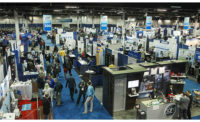Deep impact

Earlier this year, U.S. President Barack Obama signed the FDA Food Safety Modernization Act (FSMA) (P.L. 111-353), a law that will overhaul U.S. food safety for the first time since the Great Depression.

|
The legislation passed in response to a growing public concern about the integrity of both local and imported food supplies and the inability of officials to trace the sources of many tainted foods. As those involved in the food chain begin to examine the impact of FSMA, one requirement in particular is striking:
“The Secretary [is required] to establish a product tracing system to track and trace food that is in the United States or offered for import into the United States.” (FSMA d 204 (c))
Although FSMA focuses on products under the jurisdiction of the U.S. Food and Drug Administration (FDA), its provisions reflect a larger push for traceability across the entire food supply chain, including the meat and poultry under the purview of the U.S. Department of Agriculture (USDA).
The recent, deadly E. coli outbreak in Europe triggered a heightened sense of urgency and scrutiny among the public, media and lawmakers who have been pushing for more federal traceability requirements.
The trend toward stringent track-and-trace requirements could have a significant impact on the meat and poultry industry, as fresh products and the cold-chain supply industry pose special challenges to traceability. According to Dr. Don Ratliff, Regents and UPS Professor and Research Director at Georgia Tech’s Integrated Food Chain Center, any organization involved in the importation, manufacturing, production, storage, transportation and sale of food needs to understand the consequences, requirements and cost of compliance associated with FSMA and similar legislation that targets meat and poultry producers.
Traceability in black and white
The new U.S. food-safety law will most likely mean an increased burden on the bar code. Every shipment will likely carry a bar-code label that tracks at the case level where a product is produced and who produced it, as well as a unique lot number and content description.
Ratliff believes that a logistically viable solution is a dynamic tracking scenario. When product is received, information regarding product type, lot number and the name of the companies shipping and transporting the case can be captured with a bar-code scanner.
Similarly, upon shipment, information regarding product type, lot number, dispatch details and the name of the transportation supplier must be captured and recorded. This information is vital, Ratliff says, for meeting the new requirement of tracing the product “one forward and one back” in each point of the supply chain.
In addition, manufacturers, distributors and importers will need to record processing, handling, storage and transportation details for internal record-keeping.
Products will only require straightforward traceback methods because the supply chain is reasonably linear, but food processors and cold-chain operations will need more complex traceback methods.
Global standards
From cans of soup to strawberries, to meat to bottled fruit drinks, every food product is different in terms of origin, ingredients, storage, transport and shelf life. Moreover, these products are referenced differently as they pass language, culture and brand barriers. The success of a track-and-trace system, however, relies on a standardization of these diverse product descriptions that can be translated into associated database codes. Now is the time to confront and find a solution to standardize product labeling, says Ratliff. Without a global set of standards, the challenge of developing and maintaining a centralized traceability database may well become insurmountable.
Tracing food using real-time data capture and automation
The most practical way to handle the required volume of transactions is to automate the capture and upload of tracking data to an online database. This would be especially helpful in the meat and poultry industry with fresh products and temperature requirements. A Web-based system would allow officials to manage recalls more efficiently while storing data securely. However, such a database does not currently exist, and there are many issues regarding who would be responsible for storage and management of the data, pricing, etc. that need to be resolved.
As new track and trace legislation moves into the global food supply chain, manufacturers and distributors need traceability solutions now to meet compliance challenges. Material-handling automation is the key to effectively managing the workload and accuracy requirements, and solutions that address these requirements are available through suppliers in the industry.
Of course there are many benefits to material-handling automation that help justify the cost of a new system. Labor is much more efficient as demand, risk of injury and turnover decrease and efficiency increases. Food is moved more quickly and with less risk of spoiling.
An article in the June 9, 2011, Automation Skills newsletter published by Automation World magazine states: “Given the critical importance of food safety and food defense to producers, both need to be viewed not as expenses but as an important capital investment in the future of their businesses. The same return on investment (ROI) criteria should be used, just as if a new production line or packaging machine is being considered. Take, for example, the fact that an average recall costs $10 million, not counting hidden contingent costs. For a producer with $100 million in annual sales and 10 percent net margins, a recall’s cost of that size would wipe out bottom line profit for the year.”
A silver lining
Dr. Ratliff also predicts that, while there may be a significant cost burden on the food chain in order to ensure compliance with new requirements, there are also potential benefits to both consumers as well as suppliers. For consumers, the visibility and accountability in the food chain should result in enhanced food quality and freshness with less risk of contamination.
A recent survey conducted by Performance Food Group found that consumers were willing to pay $2 or $3 more for the same cut of meat if various “pleasers” were added — a higher meat quality, traceability, and improved animal handling and feeding. Supermarkets, food retailers and food suppliers can all benefit from increased “sell” life of products, better order management, fewer rejected loads, less waste because of better handling, and a quicker and more efficient way to identify where failure points occur. In the meat and poultry industry, this implies higher customer satisfaction and less risk of recall as well as higher ROI for the industry as food moves more quickly and with less risk of spoilage.
Ratliff emphasizes that, in order to receive the advantages of increased visibility, it is essential that the tracking data be standardized at the case level and that it be shared across the entire supply chain.
While many procedures are yet to be specified, FSMA provides for pilot studies to be undertaken by industry groups and organizations such as Georgia Tech’s Integrated Food Chain Center to evaluate potential tracking systems and make recommendations. Ratliff advises that food suppliers around the world should become proactive in determining how to get in front of the regulations by meeting best practices rather than waiting for mandates.
Together, automation and standardization will make it easier for food and beverage suppliers worldwide to comply with new traceability requirements and benefit from all that comes from tighter control of inventory.
For more information about FSMA and food-safety legislation under consideration in the 112th Congress, please visit http://thomas.loc.gov or http://usda.gov.
Looking for a reprint of this article?
From high-res PDFs to custom plaques, order your copy today!








